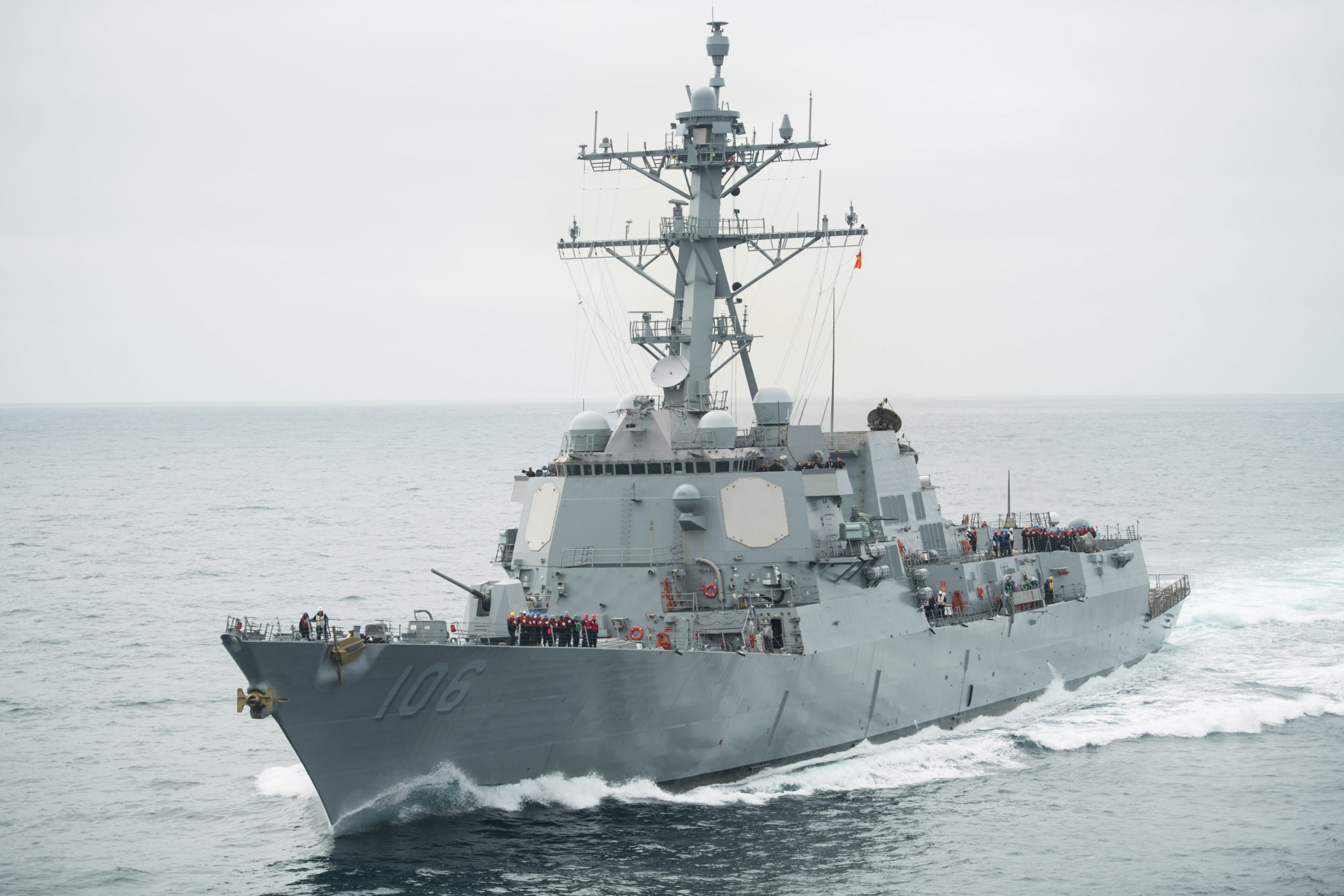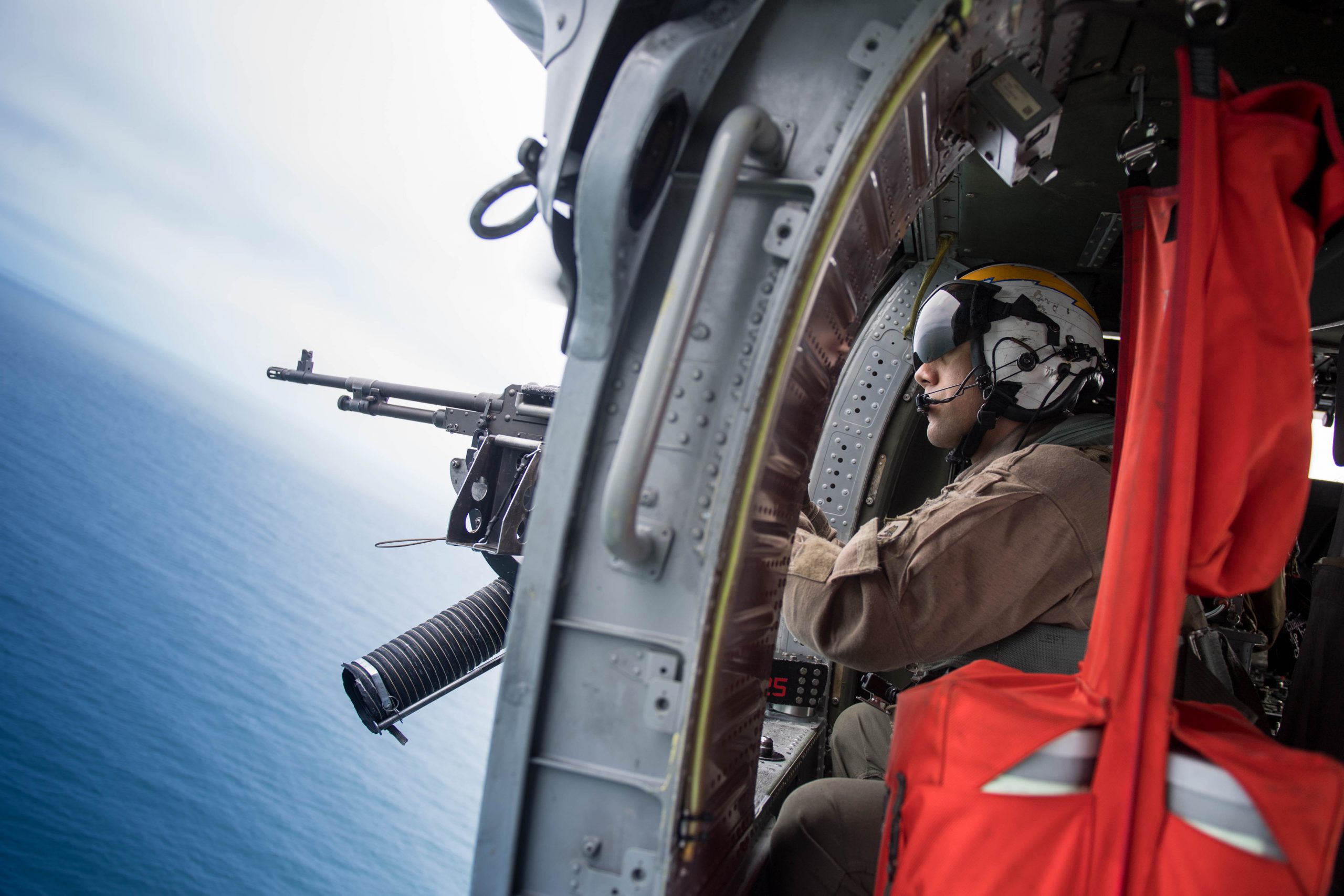Pacific Ocean — (NNS) — Carrier Strike Group (CSG) 3 has completed its group sail with USS John C. Stennis (CVN 74), Carrier Air Wing (CVW) 9, Ticonderoga-class guided-missile cruiser USS Mobile Bay (CG 53) and Destroyer Squadron (DESRON) 21.
Pacific Ocean — (NNS) — Carrier Strike Group (CSG) 3 has completed its group sail with USS John C. Stennis (CVN 74), Carrier Air Wing (CVW) 9, Ticonderoga-class guided-missile cruiser USS Mobile Bay (CG 53) and Destroyer Squadron (DESRON) 21.

Sailors from USS John C. Stennis wave to Sailors from USS Mobile Bay
Group sail provides a unique training opportunity to improve interoperability and coordination in preparation for an upcoming deployment. Integrating strike group units at sea creates the accelerated learning and training environment needed to increase effectiveness, readiness, and proficiency in the skillsets required on deployment.
"The carrier strike group is in high demand to meet national requirements as we provide an incredibly powerful diplomatic and power projection tool for our nation," said Rear Adm. Michael Wettlaufer, commander, CSG 3. "Group sail is a major step in preparing and training this force. Over the past two weeks we were able to closely coordinate planning and activities to demonstrate our capabilities and, most importantly, learn to operate safely and effectively together. We are building the cohesion across CSG 3 ships and squadrons necessary to be ready, when called, to respond as part of America's away team."

USS John C. Stennis conducts a replenishment-at-sea with oiler USNS Henry J. Kaiser
CSG 3 conducted counter piracy and maritime interdiction training, formation maneuvering, replenishments at sea, strait transits, anti-surface, anti-submarine and anti-air exercises, as well as strike mission training exercising the full range of strike group capabilities.
"Each unit in the strike group brought with it unique capabilities, strengths and areas it sought to improve," said Capt. Greg Huffman, John C. Stennis' commanding officer. "When you combine all of those talents, they serve to enhance one another. We can't do this mission independent of one another, and the performance I saw during group sail leaves no doubt we will be ready when called upon, anywhere we are needed around the world."

USS Stockdale prepares for a replenishment-at-sea with USS John C. Stennis
Group sail was the first opportunity for the different warfare commanders to execute command and control over the full range of capabilities inherent to the strike group.
"During group sail we began to increase the tempo and complexity of our operations, both as the Strike Warfare Commander, projecting naval power ashore, and in support of the other warfare areas," said Capt. Steven Hejmanowski, commander, CVW 9.

Lt. Justin Otto gives the signal to launch an F/A-18E Super Hornet
With five ships, more than 50 aircraft and more than 6,000 Sailors, carrier strike groups can carry out simultaneous missions across multiple mission areas. The flexibility and readiness to meet any mission required are what makes CSGs the versatile and adaptable response option. Their ability to operate anywhere in the world without the requirements of shore-based infrastructure are mission enablers.
"The ships and aircraft of the strike group can reach almost anywhere in the world," said Capt. James Storm, Mobile Bay's commanding officer. "Seventy percent of the world is ocean, and we can reach nearly every corner of it, bringing everything we need to carry out our full range of missions, from providing humanitarian assistance to ensuring the freedom of navigation around the word to, if necessary, carrying out kinetic strikes to defeat our nation's enemies."

Naval Air Crewman mans a .50-caliber machine gun inside an MH-60S Sea Hawk
Working together for the first time in over two years, the units comprising CSG 3 worked seamlessly, as if they had been training together on a constant basis.
"Before we came together for Group Sail, all of our units had conducted training with some of the others, but never all together," said Capt. Henry Adams, commodore, DESRON 21. "But it isn't until we came together again that we could really exercise our full capabilities and begin to regain the honed edge of expertise across the wide range of missions uniquely brought by the combination of an aircraft carrier, destroyer squadron, carrier air wing and guided missile cruiser."
Providing a combat-ready force to protect collective maritime interests, CSG 3 demonstrated exemplary performance and exhibited continued professionalism, a reflection of the Sailors that work hard every day to stay prepared for the upcoming deployment.
CSG 3 is underway conducting group sail training in preparation for its next scheduled deployment.
CVW 9 includes Helicopter Maritime Strike Squadron (HSM) 71, Helicopter Sea Combat Squadron (HSC) 14, Airborne Early Warning Squadron (VAW) 117, Electronic Attack Squadron (VAQ) 133, and Strike Fighter Squadrons (VFA) 151, 97, 41 and 14. DESRON 21 includes USS Stockdale (DDG 106), USS Spruance (USS 111), and USS Chung-Hoon (DDG 93).
For more news on John C. Stennis, visit www.stennis.navy.mil or follow along on Facebook at www.facebook.com/stennis74.










